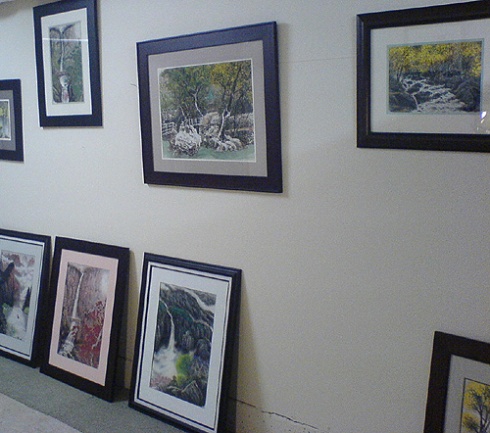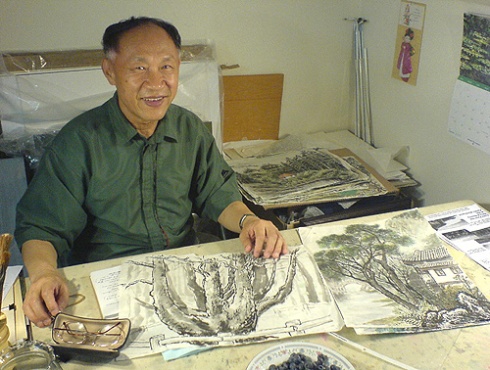From art to geology and back to art again, Ming Wei‘s life has straddle two fields that, at first glance, seem opposite to each other — ink brush painting and the study of earth’s structure and substance. But before long, you will see that in each, Ming has been conducting a dialog with nature, coming to an understanding of the spirit of the landscape through his study of geology, and then expressing that understanding through his art.
Since immigrating to the Pacific Northwest in 2004 to be with his daughter Susan, Ming has discovered the landscape of the region, going out with a plein air painting group to make impressionistic sketches and finished compositions at places such as Multmomah Falls, and then returning to the studio to paint from memories of the visits. As Ming explains, xuxu-shishi, the contrast between the imagined vs. the real, is an important quality in Chinese painting. Through his plein air painting and studio work, Ming has been able to examine and express both the real and the imagined.
Below, a view of Ming’s studio.
While he has immersed himself in the environment of his new home, he continues to work with tools and materials that his daughter brings back from China during her many business trips — brushes made from wolf’s hair (prized for its springiness) and sheep’s hair (prized for its absorbency), xuan paper (also spelled shuen), both in ‘raw’ and ‘cooked’ forms. The different brushes and different papers are used for different styles of painting and calligraphy. Ming practices both the gongbi and the xieyi styles of painting. To someone who is not a practitioner, the two styles can be roughly distinguished as ‘realistic’ (gongbi) vs. ‘impressionistic’ (xieyi). Ming gives a more nuanced explanation of the two:
Xieyi (literally ‘writing ideas’) — brushwork of the Southern school, supple in general appearance, but the individual storkes are firm. Paintings in this style are typically signed by the artist as ‘written by.’
Gongbi (literally ‘fine brushwork’) — style of the Northern school, it is the opposite of xieyi — the individual strokes are supple, but the overall appearance is firm. Artists sign gongbi paintings as ‘made by.’
Below, Ming at this work table, with a few of his plein air sketches.
Just as Ming has lived and worked as both scientist and artist, and his art has spanned both the Southern and Northern schools, his subject matter also crosses boundaries. From landscapes to flora & fauna, Ming combines the observation skills of a scientist with the sensitivity of an artist to depict the xuxu-shishi view of the world around us.
During Portland Open Studios, Ming will be assisted by his daughter Susan, a clothing and textiles engineer. Susan is a gracious host and capable translator who clearly adores her talented father. To witness their warm and loving interactions with each other is an added bonus for any visitor to Ming’s studio.
After Portland Open Studios, Ming has two more exhibits coming up — one March through May and another in August, both 2008. To find out more about these and other coming events, please see Ming’s blog at http://www.mingxwei.blogspot.com.



Leave a comment
Comments feed for this article